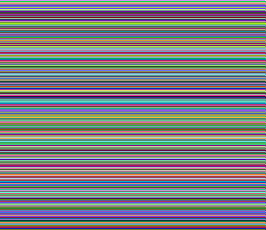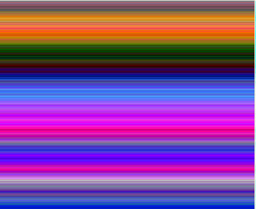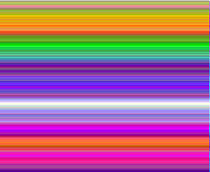MiniRobotLanguage (MRL)
CCV. Command
Convert and split RGB/BGR Color
Intention
This command will help you to handle the Red,Green and Blue Values of 24/32 bit Colors.
There are several Modes of operation for the CCV.-Command.
Using the "H" and "K"-Modes, you can use the command to convert a decimal number to Hexadezimal (HEX) Color values.
Using other Modes (X,Y,U and V) you can use the command to generate random numbers and colors.
1. Convert RGB-Color to BGR Color
CCV.BGR|$$RGB|$$BGR
2. Convert BGR-Color to RGB Color
CCV.RGB|$$BGB|$$RGR
3.Convert Color value into Hexadezimal
CCV.H|$$COL|$$HEX
4.Swap R/B Color value and convert into Hexadezimal
CCV.K|$$COL|$$HEX
Here is a Sample script, using both features:
$$RGB=&H00FF10
CCV.BGR|$$RGB|$$BGR
CCV.H|$$BGR|$$RES
DBP.$$RES
ENR.
' Result is: &H10FF00
Also you can use the CCV. command to mix the RGB-parts into one color value.
5. Convert RGB-Color parts to BGR Color
CCV.BGR|$$RED,$$GRN,$$BLU|$$BGR
6. Convert BGR-Color parts to RGB Color
CCV.RGB|$$RED,$$GRN,$$BLU|$$RGR
Here is a Sample script, using this features:
$$RED=&H00
$$GRN=&HFF
$$BLU=&H10
CCV.BGR|$$RED,$$GRN,$$BLU|$$BGR
CCV.K|$$BGR|$$RES
DBP.$$RES
ENR.
' Result is: &H10FF00
Third you can use the CCV. command to split a color value into its R,G and B part.
7.Split Color value into RGB values
CCV.Split|$$COL|$$RED,$$GRN,$$BLU
8.Split Color value into BGR values
CCV.T|$$COL|$$RED,$$GRN,$$BLU
Here is a Sample script, using this features:
$$RGB=&H00FF10
CCV.T|$$RGB|$$RED,$$GRN,$$BLU
$$RES=$$RED-$$GRN-$$BLU
DBP.$$RES
ENR.
' Result is: 0-255-16
Fourth CCV. can be used to generate Random colors. There are are two random-number algorithms. The results are best described with these two pictures.

Algo 1 will use total random colors that are in no relation to the previous color.
Here is thesample program for algo 1:
UCV.nbi
UCV.cov
FOR.$$Y00|1|500
CCV.x|$$RED,$$GRN,$$BLU
CCV.r|$$RED,$$GRN,$$BLU|$$RGB
UCV.fgr|$$RGB
UCV.Line|0,$$Y00|500,$$Y00
NEX.
PAU.3
ENR.

Algo 2 will generate random numbers that are near the previous random number by the given additional value. Here a value of 25 was used.
Here is the sample program for algo 2, change the value of $$VAL to see the differences:
'#SPI:forcewrite
$$VAL=25
UCV.nbi
UCV.cov
FOR.$$Y00|1|500
' CCV.x|$$RED,$$GRN,$$BLU
CCV.y|$$VAL|$$RED,$$GRN,$$BLU
CCV.r|$$RED,$$GRN,$$BLU|$$RGB
UCV.fgr|$$RGB
UCV.Line|0,$$Y00|500,$$Y00
NEX.
PAU.3
ENR.

Here a value of 35 was used.
Syntax
CCV.[P1][|P2][,P3]
Parameter Explanation
P1 - prototypes
RGB - convert input to RGB
CCV.RGB|$$RED,$$GRN,$$BLU|$$COL
CCV.RGB|$$INP|$$COL
You can use 3.4 System-Colors values like S1,S2 etc.
BGR - convert input to BGR
CCV.BGR|$$RED,$$GRN,$$BLU|$$COL
CCV.BGR|$$INP|$$COL
You can use 3.4 System-Colors values like S1,S2 etc.
Split - Split Input into RGB-values
CCV.Split|$$COL|$$RED,$$GRN,$$BLU
T - Split into RGB and Swap R and B value
CCV.Split|$$COL|$$RED,$$GRN,$$BLU
H - Convert number to Hexadezimal
CCV.H|$$NUM|$$RES
You can use this to see the values of 3.4 System-Colors
like S1,S2 etc. Example:
' Show value od System color S2
CCV.H|S2|$$HEX
DBP.$$HEX
K - Swap R and B value and Convert number to Hexadezimal
CCV.K|$$NUM|$$RES
X - Generate random color (algo 1)
CCV.X|$$RED,$$GRN,$$BLU
Y - Generate random color (algo 2 using $$VAL)
CCV.Y|$$VAL|$$RED,$$GRN,$$BLU
U - Generate random color (algo 1)
CCV.U|$$COL
V - Generate random color (algo 2 using $$VAL)
CCV.U|$$VAL|$$COL
The parameters P2 and P3 depend on the mode of operation.
Example
'***********************************
' CCV.-Sample
'***********************************
'
CCV.RGB|&HFF,&H00,&HFF|$$RES
DBP.$$RES
CCV.S|16711935|$$RED,$$GRN,$$BLU
DBP.$$RED,$$GRN,$$BLU
ENR.
'***********************************
' CCV.-Sample
'***********************************
'
$$RGB=16711939
CCV.RGB|$$RGB|$$BGR
DBP.$$BGR
ENR.
'***********************************
' CCV.-Sample
'***********************************
'
'#SPI:forcewrite
$$VAL=35
UCV.nbi
UCV.cov
FOR.$$Y00|1|500
' CCV.x|$$RED,$$GRN,$$BLU
CCV.y|$$VAL|$$RED,$$GRN,$$BLU
CCV.r|$$RED,$$GRN,$$BLU|$$RGB
UCV.fgr|$$RGB
UCV.Line|0,$$Y00|500,$$Y00
NEX.
PAU.3
ENR.
Remarks
When specifying Colors as hexadecimal values, prefer using this format:
&H0FFFFFF.
RRGGBB
If you omit the "&H0" or just use the "&H" this may lead to strange results when the values is converted to decimal. The reason for this is::
&HFFFF is -1 (conversion to signed number using "&H")
while
&H0FFFF is 65535 (conversion to unsigned number using "&H0")
as expected.
Limitations:
-
See also:
• ! Smart Package Robot 's Pixel-Operations
• ! UCV. - Undercover Graphics
• IDP. / NDP. - If desktop dpi Setting
• IPC. / NPC. - If-Pixel-Colour
• ! UCV. - Undercover Graphics